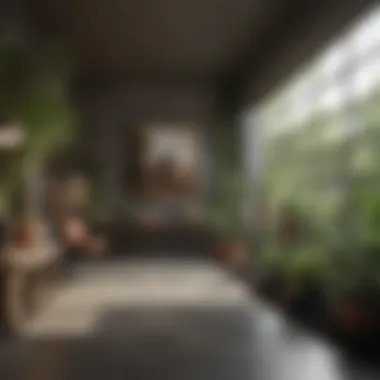The Impact of ASID Designers on Interior Spaces


Intro
The significance of ASID designers extends beyond mere aesthetics. These professionals embody principles that intertwine functionality with beauty. In various spaces, they transform environments that not only please the eye but also enhance sustainable living. Their education and certification reflect commitment to the craft, empowering them to stay relevant amid ever-evolving design trends. This article will explore these dimensions, shedding light on how ASID designers play an integral role in shaping our surroundings.
Design Inspiration
Design inspiration comes from understanding the current interior design trends that hold sway in today's market. ASID designers are often at the forefront of these shifts, implementing innovative ideas and fresh concepts into their projects.
Current Interior Design Trends
Several recognizable trends shape the interior design landscape:
- Biophilic Design: Emphasizing a connection to nature, this trend integrates natural elements into spaces. It is about using materials that reflect the environment, promoting wellbeing.
- Minimalism: Clean lines and simplicity dominate. The goal is to create uncluttered spaces that feel open and functional.
- Smart Home Integration: Technology plays a vital role. ASID designers increasingly work with smart home devices to create functional and tailored living spaces.
- Sustainable Materials: There is a strong focus on using eco-friendly materials. Designers must be creative and resourceful to ensure sustainability while maintaining aesthetic quality.
Color Palettes and Their Effects
Color plays a crucial role in setting the mood within any space. ASID designers are trained to understand the psychological effects of color. For example:
- Warm Colors: Reds, oranges, and yellows can energize a room, invoking a sense of warmth and comfort.
- Cool Colors: Blues and greens often bring calmness and serenity, making them perfect for bedrooms and relaxation spaces.
- Neutral Shades: Whites, grays, and beiges serve as versatile backdrops, providing a sense of balance and elegance.
The strategic selection of a color palette can greatly influence how a space is perceived. The designers' proficiency in creating harmonious and inviting environments is vital.
As the article progresses, it will delve deeper into how ASID designers adapt to changing trends and how their unique skills benefit homeowners and spaces alike.
Prelims to ASID Designers
The realm of interior design is complex, yet the presence of ASID designers brings clarity and expertise. Their influence shapes not only the aesthetics of a space but also its functionality and livability. Understanding the role of ASID designers is essential for anyone looking to enhance their home or workspace effectively.
Understanding ASID
The American Society of Interior Designers (ASID) represents a community of professionals dedicated to advancing the discipline of interior design. ASID is not just an organization; it is a standard of excellence in the field. By adhering to its guidelines, designers ensure that they meet the highest levels of education and professional practice. The organization emphasizes the importance of evidence-based design and ensures that its members engage in ongoing professional development. For homeowners and design enthusiasts, engaging with ASID designers means collaborating with individuals committed to quality, ethics, and innovation in their work.
The Role of ASID Designers
ASID designers play a pivotal role in transforming spaces. Their expertise goes beyond mere decoration; it involves strategic planning and a deep understanding of how environments affect human behavior. They assess client needs, considering both practical requirements and aesthetic preferences. A successful ASID designer often acts as a project manager, guiding clients through the entire design process, from conceptualization to execution.
These designers utilize a systematic approach to space planning, ensuring that every corner serves a purpose while also contributing to the overall visual appeal. They are skilled at balancing functionality with style, making informed choices about materials, colors, and layouts. The outcome is a cohesive environment that resonates with the inhabitants' lifestyle and preferences.
Additionally, ASID designers are particularly attuned to current trends in sustainable practices and smart home integration. They often advocate for environmentally friendly solutions that not only beautify but also enhance the efficiency of spaces. This holistic approach is integral in today’s design landscape, where sustainability and technology play an increasing role. Through their dedication and comprehensive understanding of these elements, ASID designers truly exemplify how thoughtful design transforms not just interiors, but the way individuals experience their environments.
Education and Certification
Education and certification are fundamental components in the journey of an ASID designer. These elements establish the competency, knowledge, and professionalism necessary to excel in interior design. ASID designers bring aesthetics and functionality to various spaces. Their education serves as a backbone, providing them a robust understanding of design principles, materials, and human interaction with space. Without the right educational framework, their efforts might lack the insightful foundation required to achieve transformative results.
In today's competitive landscape, certification also plays a crucial role. It not only signifies a designer's expertise but also reassures clients of their qualifications. When homeowners or businesses engage with ASID designers, they are often looking for assurance that their project is in capable hands. Furthermore, the certification process often requires ongoing education to maintain, which ensures that designers stay updated on current trends, technologies, and best practices. This lifelong learning approach is vital in a field as dynamic as design, where preferences and technologies shift frequently.
Required Degree Paths
The educational pathway for an ASID designer typically begins with obtaining a bachelor's degree in interior design or a related field. This degree encompasses a range of topics, from architectural history to color theory, and also includes hands-on studio work.
Common degree programs include:
- Bachelor of Science in Interior Design
- Bachelor of Fine Arts in Interior Design
- Master of Interior Design (for further specialization).
Most academic programs are accredited by the Council for Interior Design Accreditation (CIDA), which ensures that the curriculum meets quality standards. While some designers may enter the field with only an associate's degree or substantial experience, a four-year degree is often viewed as the best preparation for a successful career.
Certification Process
After completing their education, aspiring ASID designers must navigate the certification process. There are specific requirements to sit for the National Council for Interior Design Qualification (NCIDQ) exam. Candidates typically need to have both a degree and practical experience, which varies depending on the type of degree held.
The NCIDQ exam tests knowledge in areas such as:
- Design application
- Building systems
- Codes and regulations
Once certified, designers can proudly display their abilities to clients and fellow professionals. This certification enhances credibility and can distinguish a designer in a saturated market.


In summary, education and certification are key pillars in the profession of ASID designers. These aspects not only shape their skills but also influence how they transform spaces for various audiences.
Design Principles and Ethics
The design principles and ethics are essential to ensure that ASID designers create spaces that are not only visually appealing but also functional and responsible. These principles guide designers in making decisions that enhance the quality of life for occupants. They also play a vital role in ensuring sustainability, social responsibility, and client satisfaction. Understanding these topics is crucial for any homeowner or design enthusiast, as they lay the groundwork for transformative spaces that cater to human needs.
Core Design Principles
Core design principles serve as the foundation upon which ASID designers build their projects. These principles include:
- Functionality: Each space should serve its intended purpose well. Designers consider how people interact with the space and what activities will take place within it.
- Form: The visual aspect of a design is equally important. The shape, color, and style of furniture and fixtures must complement the overall aesthetic.
- Balance: Achieving balance involves the distribution of visual weight. Designers strive for equilibrium through symmetry or asymmetry, enhancing the space's harmony.
- Scale and Proportion: These elements ensure that the size of various components is appropriate to each other and to the entire space. Proper scaling enhances comfort and usability.
- Contrast: Introducing contrasting elements can add depth and interest to a design. This can involve a mix of colors, textures, and styles.
By adhering to these core design principles, ASID designers create spaces that feel cohesive and enjoyable, contributing to overall well-being. The appropriate application of these elements can elevate a space from ordinary to extraordinary.
Ethical Considerations
Ethics in design are equally critical, particularly as the industry evolves with new challenges. Ethical considerations include:
- Sustainability: Designers must strive to use materials and processes that do not harm the environment. Sustainable design practices minimize waste and promote energy efficiency.
- Client Well-being: ASID designers hold a responsibility to create spaces that promote the health and well-being of occupants. This includes considering lighting, air quality, and ergonomics.
- Inclusivity: Designing for varied abilities and backgrounds is essential. Spaces should be accessible to everyone, regardless of age or mobility.
- Transparency: Ethical designers communicate openly with clients about design choices, costs, and timelines. This builds trust and ensures clients are fully informed.
Design ethics ultimately guide ASID designers to create spaces that reflect a commitment to human dignity and environmental responsibility.
"Design is not just what it looks like and feels like. Design is how it works." — Steve Jobs
These principles and ethical considerations are what transform spaces effectively, creating a positive impact in people's lives.
Styles and Aesthetics
Understanding styles and aesthetics is essential in the realm of ASID designers. These designers shape how a space feels and functions through the lens of diverse design philosophies. Every style conveys a specific message, speaks to the identity of the homeowner, and creates experiences that resonate with those who inhabit these spaces. The effectiveness of a design is often judged on how well it harmonizes form and function, thereby enhancing the overall living experience.
Key elements in styles and aesthetics include:
- Color Palette: The choice of colors influences mood and perception.
- Space Usage: Every layout serves multiple purposes, making it crucial to design intelligently.
- Textures and Materials: These add depth and tactile quality to spaces.
The benefits of understanding styles and aesthetics are manifold. Homeowners gain clarity in their preferences, which aids in the selection of designs that resonate with their personalities. Furthermore, effective aesthetic choices can increase property value, making well-designed spaces more appealing to future buyers.
Contemporary Designs
Contemporary designs are characterized by their clean lines and minimalist approach. These designs often incorporate innovative materials and eco-friendly practices. ASID designers focus on fluidity of the space by integrating open floor plans and combining indoor and outdoor elements.
In contemporary aesthetics, color plays a pivotal role. Neutral tones dominate, serving as a backdrop for more vibrant accents. The integration of technology is further significant. Smart home features blended with aesthetics create a seamless lifestyle experience. By utilizing sustainable materials, contemporary design aligns with current trends that favor environmental responsibility.
Traditional Designs
Traditional designs draw inspiration from various historical elements, creating a sense of timelessness. ASID designers emphasize symmetry and elegance, which is often reflected in ornate detailing and classic furnishings. Spaces designed in this style communicate comfort and a sense of belonging.
Key aspects of traditional designs include rich color palettes featuring deep hues, intricate patterns, and classic furniture pieces. The craftsmanship in traditional materials such as wood and upholstery elevates the overall aesthetic. Designers often source these materials to preserve authenticity in their work.
Eclectic Approaches
Eclectic approaches embrace a mix of styles, combining different elements to produce unique and vibrant spaces. This style is not confined by any single aesthetic but rather draws from a variety of influences. ASID designers who excel at eclectic design can weave together contrasting textures, colors and furniture types, allowing for a personalized touch.
Critical points in eclectic aesthetics include:
- Layering: Combining various elements to create depth and interest.
- Cohesion: Despite diversity, a unifying theme or color scheme can tie different styles together.
- Artistic Expression: Artifacts and personal touches can reflect individual stories and experiences.
Designing with an eclectic approach allows homeowners to create lively spaces that reflect their personality, ensuring no two homes are alike.
"In the hands of ASID designers, styles become more than just visual choices; they reflect values, lifestyle, and the heart of a home."
Current Trends in Interior Design
Current trends in interior design highlight how ASID designers adapt to changing preferences and innovations. Understanding these trends is critical as they shape the way spaces are designed. Designers not only create aesthetically pleasing environments but also ensure that these spaces functional and sustainable. Two prominent trends stand out today: sustainable practices and smart home integration.
Sustainable Practices
Sustainable practices in interior design emphasize environmental responsibility. ASID designers are increasingly focusing on eco-friendly materials and processes. This involves selecting products that are sustainably sourced, such as reclaimed wood, bamboo, and non-toxic paints. Additionally, the use of energy-efficient lighting and appliances can drastically reduce a space's overall carbon footprint.


Incorporating sustainable design elements offers several benefits:
- Healthier Environments: Using non-toxic materials helps improve indoor air quality.
- Cost Savings: Energy-efficient designs can lower utility bills over time.
- Positive Impact: Designers contribute positively to the environment by reducing waste and promoting recycling.
Key Considerations for Sustainable Practices:
- Material Selection: Always choose materials that have a minimal impact on the environment.
- Waste Management: Implement recycling plans during the design process.
- Sustainable Sourcing: Source products and furniture from manufacturers that focus on eco-friendly practices.
"Designing with intention can create spaces that are both beautiful and responsible, reflecting a commitment to the planet and its resources."
Smart Home Integration
Smart home integration has reshaped interior design, blending technology with functionality. ASID designers are expected to incorporate smart technology that enhances user experiences. This can include automated lighting, smart thermostats, and home security systems. Not only does this technology provide convenience, but it also boosts energy efficiency.
The integration of technology in design has several implications:
- Enhanced Control: Homeowners can control various aspects of their home environment with ease.
- Energy Management: Smart devices help manage energy use, reducing wastage.
- Convenience: Automated features simplify tasks and improve living comfort.
Designers must consider the following when integrating smart technologies:
- User-friendly Solutions: Ensure that technology is easy to use for all ages.
- Aesthetic Appeal: Technology should blend seamlessly with the overall design theme.
- Future-Proofing: Design with adaptability in mind so future technologies can be easily integrated.
As ASID designers navigate these current trends, their role extends beyond aesthetic improvement. They are vital in creating adaptable, thoughtful environments that cater to modern needs, support sustainability, and enhance living experiences.
The Importance of Collaboration
Collaboration is a crucial element in the work of ASID designers. It not only enhances the design process, but also ensures the functionality and aesthetic appeal of a space. When ASID designers work together with other professionals, like architects and builders, they can integrate diverse skills and perspectives. This synergy leads to more holistic and well-thought-out designs that fulfill the client's needs and preferences.
The benefits of collaboration extend beyond mere aesthetics. It fosters clear communication between team members, which minimizes the risk of misunderstandings. Working closely allows for the exchange of ideas and insights that may not arise in isolation. Moreover, it helps in managing resources efficiently, thus adhering to time schedules and budgets. A collaborative approach enhances creativity, encouraging a combination of different ideas that can inspire innovative solutions.
Working with Architects
ASID designers play a vital role when collaborating with architects. The architect establishes the structural framework of a building, while the designer focuses on its interior functionality and visual appeal. Effective communication between these two professions is essential.
- Complementary Goals: Architects and designers aim to create spaces that are not only safe and functional but also inviting and aesthetically pleasing. By discussing goals early in the project, both parties can ensure that their visions align.
- Coordinated Plans: Collaboration allows for the exchange of sketches and design plans. This coordination helps both professionals understand how their work complements each other, thus reducing the chances of conflicts during implementation.
- Problem Solving: During construction, challenges often arise that require immediate solutions. A collaborative environment encourages quick discussions that can offer effective solutions.
Team Dynamics in Large Projects
In large projects, team dynamics become especially important. ASID designers, architects, contractors, and other stakeholders must function cohesively to transform concepts into reality.
- Clear Roles: Defining specific roles and responsibilities among team members increases accountability. Each participant knows what they are responsible for, reducing overlapping efforts and confusion.
- Regular Meetings: Frequent check-ins help sustain momentum and address any issues that may develop. These meetings can be used for updates and adjustments, ensuring everyone is on the same page.
- Respect for Expertise: Each team member brings their unique skills to the table. Recognizing and valuing these skills fosters a positive working atmosphere, important for maintaining morale and motivation.
Working collaboratively results not just in successful projects, but also in satisfied clients and improved design outcomes. The importance of cooperation cannot be understated; it is beneficial for both the creators and the clients they serve.
"Collaboration is the key to successful design. It opens opportunities for growth and innovation that cannot be realized alone."
Through collaboration, ASID designers truly elevate the spaces they work on, transforming them into functional environments that reflect the aspirations of their clients.
Challenges Faced by ASID Designers
The interior design industry presents several challenges that ASID designers must navigate to effectively transform spaces. These challenges are crucial to understand as they directly influence the outcome of design projects and the satisfaction of clients. By acknowledging these difficulties, one can appreciate the skills and strategies designers employ to address them.
Budget Constraints
Budget constraints are often at the forefront of challenges ASID designers encounter. Most clients come with a predefined budget, and this can limit the options available. Designers must often make difficult decisions about materials, furnishings, and the overall scope of the project. The balance between quality and cost becomes a delicate dance.
- Cost-effective solutions: Designers have to find ways to deliver aesthetic satisfaction while staying within budget. This might include sourcing materials that look high-end but are more affordable.
- Prioritizing needs: Identifying which elements are essential and which are optional helps streamline the design process and budget.
- Transparent communication: It is vital for designers to discuss budget limitations with clients from the beginning to avoid later misunderstandings.
Since each project is unique, dealing with budget constraints requires flexibility and creativity. These skills define a good ASID designer.
Client Expectations
Client expectations can differ widely, and managing them is another significant challenge ASID designers face. Each client comes with their vision, preferences, and experiences, which can lead to varying degrees of understanding about the design process.
- Setting realistic goals: Designers must guide clients in understanding what is achievable within their timelines and budgets. Clear communication helps in aligning expectations.
- Regular updates: Keeping clients in the loop about progress and potential issues can build trust and satisfaction. This can be done through meetings or progress reports.
- Feedback incorporation: Designers should be prepared to adapt to client feedback, balancing personal artistic vision with client preferences.


Effective expectation management is essential for fostering a positive relationship, ultimately leading to successful project outcomes. Designers must hone their communication and negotiation skills to navigate these dynamics effectively.
"A successful ASID designer not only creates beautiful environments but also bridges the gap between client dreams and practical realities."
In summary, the challenges of budget constraints and managing client expectations are intrinsic to the work of ASID designers. Understanding these hurdles provides a deeper insight into the transformative role these professionals play in creating functional and appealing spaces.
Creating Functional Spaces
Creating functional spaces is essential in the realm of interior design. It ensures that every area serves a purpose while reflecting the aesthetic desires of the client. The importance of this process lies in its ability to blend practicality with creativity, making spaces not only beautiful but livable and usable.
There are specific benefits that arise from the practice of creating functional spaces. Firstly, it promotes a sense of organization and efficiency within a space. Homeowners often seek designs that maximize use while maintaining an inviting atmosphere. Furthermore, functional design optimizes the flow of movement, preventing congestion and enhancing everyday tasks.
When tackling functional space creation, several considerations are vital:
- Client Needs: Understanding the specific needs and lifestyle of the client is crucial. Each family or individual may have different habits and preferences that affect design choices.
- Space Utilization: Assessing how each area is currently used informs better decisions moving forward.
- Versatile Furniture: Utilize adaptable pieces which can serve multiple functions. For example, a sofa bed can accommodate guests without sacrificing space.
- Storage Solutions: Clever storage designs can reduce clutter while increasing overall functionality. This might include built-in shelving, under-bed storage, or hidden cabinets.
In essence, creating functional spaces is much more than arranging furniture. It’s about crafting environments that enhance life through thoughtful design. This process sets the stage for the next sub-topic, where we delve deeper into the specific space planning techniques used by ASID designers to achieve these goals.
Space Planning Techniques
Space planning is a critical aspect of interior design that focuses on the arrangement and organization of various elements within a space. Efficient space planning techniques allow designers to visualize how areas interact and flow into one another.
Some key techniques include:
- Furniture Layout: Determining the optimal placement of furniture ensures ease of movement and encourages social interaction. For example, arranging seating around a coffee table promotes conversation in a living room.
- Zoning: This involves defining specific areas for different activities, such as a reading nook or a dining area. Zoning can be achieved using rugs, lighting, or furniture arrangement.
- Traffic Flow: Understanding how people navigate through the space is important. Designers should avoid dead ends and ensure that pathways are clear and intuitive.
- Proportion and Scale: Choosing appropriately sized furniture ensures that the space does not feel overcrowded or sparse. An oversized sofa in a small room can create visual imbalance.
- Lighting Considerations: Effective use of natural and artificial light can influence how a space feels. Task lighting in work areas and ambient lighting in relaxation zones enhance functionality.
By applying these techniques, ASID designers can optimize space effectively, catering to the diverse needs of their clients.
Designing for Accessibility
Designing for accessibility addresses the need for spaces to be usable by people of all abilities. This aspect is not only a legal requirement in many areas but also a moral one. ASID designers must consider age, mobility, and other factors when creating spaces that are accessible.
Important considerations include:
- Entrances and Exits: Ramps may be necessary alongside or in place of stairs to ensure smooth entry and exit.
- Width of Aisles: Ensuring that pathways are wide enough accommodates wheelchairs and walkers, enhancing overall navigation.
- Bathroom Layout: Grab bars, non-slip flooring, and lower sinks make bathrooms more user-friendly for everyone.
- Adjustable Features: Adjustable counters or cabinets help cater to users sitting or standing.
- Signage: Clear signage enhances wayfinding, particularly for individuals with cognitive disabilities.
Creating spaces that account for accessibility benefits everyone. It fosters an inclusive atmosphere where all individuals feel comfortable and valued. The attention to such details demonstrates a commitment to designing a better world, reflecting the ethos of ASID designers.
The Future of ASID Designers
In an ever-evolving world, the future of ASID designers holds immense importance for the interior design industry. As societies change, so do the needs and preferences of homeowners and businesses. Designers affiliated with the American Society of Interior Designers (ASID) are at the forefront of this transformation. They not only respond to current demands but also anticipate future trends and challenges in creating functional and aesthetically pleasing spaces.
Evolving Design Trends
The landscape of interior design is continually shifting due to cultural influences, environmental concerns, and advancements in design methodologies. In recent years, the emphasis on sustainability has risen. Consumers are increasingly aware of their environmental footprint and seek designs that incorporate eco-friendly materials and practices.
ASID designers must remain adaptable, incorporating trending elements without sacrificing timeless appeal. For instance, biophilic design—where natural elements are integrated into interior spaces—has gained popularity. This approach enhances well-being and connects individuals to nature. Designers are also experimenting with flexible spaces that serve multiple purposes, catering to the changing lifestyles of their clients.
Technological Advancements
Another significant aspect of the future involves technological advancements. Smart home technology is no longer a luxury but a common expectation among clients. ASID designers need to be educated about the latest innovations—from automated lighting systems to energy-efficient appliances—to integrate these elements seamlessly into their designs. By doing so, they not only enhance the functionality of spaces but also appeal to the tech-savvy consumer.
Moreover, design software has also evolved. Tools like SketchUp and AutoCAD are becoming more sophisticated, allowing designers to create more accurate representations of their ideas. Virtual reality is being explored as a means to give clients an immersive preview of their potential spaces.
"The future of ASID designers hinges on their ability to integrate emerging trends and technologies while staying true to their core principles of aesthetics and functionality."
As these factors continue to shape the role of ASID designers, it is crucial for them to remain informed and agile. Embracing change will ensure that they not only meet the expectations of their clientele but also contribute positively to the overall evolution of interior design into the future.
Epilogue
The conclusion of this article encapsulates the pivotal role that ASID designers play in shaping not only the physical spaces we inhabit but also our experiences within them. As experts in both aesthetics and functionality, these designers address the unique needs of each client while incorporating sustainable practices and current trends. Their influence is profound, leading to environments that are not only visually appealing but also practical and responsive to modern living.
Recap of Key Points
- Expertise in Design: ASID designers possess specialized knowledge that allows them to transform spaces effectively. They understand the intricacies of spatial arrangement, color theory, and the psychology of design.
- Education and Certification: Through rigorous educational paths and certification processes, ASID designers are equipped to handle complex design challenges. This ensures they maintain high professional standards.
- Diverse Styles: With a broad range of styles from contemporary to traditional, these designers create spaces that resonate with individual tastes and preferences. They adapt designs to mesh with the client's vision.
- Sustainability: A commitment to sustainable practices addresses today's environmental concerns. ASID designers select materials and methods that reduce ecological impact while enhancing space functionality.
- Collaboration: Successful projects often require collaboration between ASID designers, architects, and other professionals. This teamwork ensures comprehensive approaches to space transformation.
The Lasting Impact of ASID Designers
The impact ASID designers have extends well beyond mere aesthetics. They contribute to significant changes in how people interact with their environments. For homeowners, the thoughtful design promotes well-being, encourages productivity, and often increases property value. In commercial settings, a well-designed space can enhance employee satisfaction and client experiences.
Furthermore, ASID designers advocate for accessibility and inclusion. They consider the needs of all individuals, ensuring that spaces are welcoming and usable for everyone. This consideration helps redefine what spaces mean to those who inhabit them, encouraging a more equitable approach to design.
As we look to the future of interior design, the work of ASID designers will increasingly reflect our collective values, prioritizing wellness, sustainability, and inclusivity at every turn.















